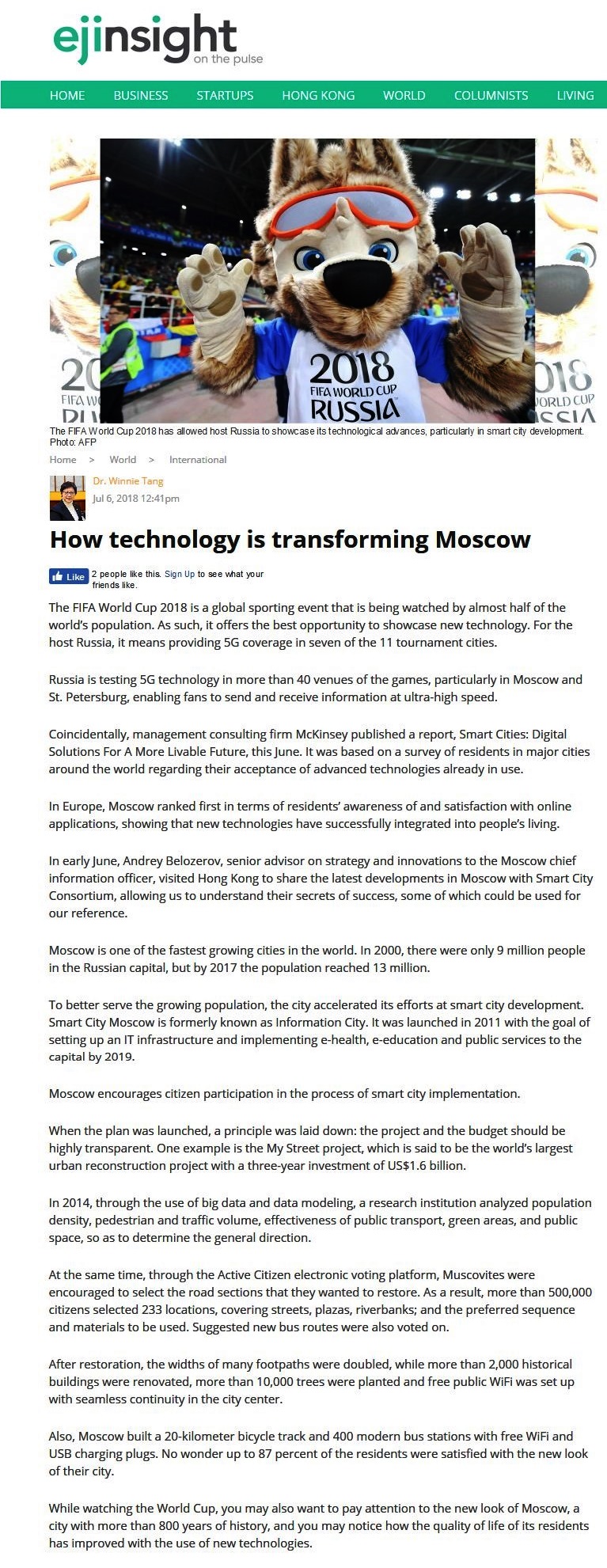網上版請按此

How technology is transforming Moscow
The FIFA World Cup 2018 is a global sporting event that is being watched by almost half of the world's population. As such, it offers the best opportunity to showcase new technology. For the host Russia, it means providing 5G coverage in seven of the 11 tournament cities.
Russia is testing 5G technology in more than 40 venues of the games, particularly in Moscow and St. Petersburg, enabling fans to send and receive information at ultra-high speed.
Coincidentally, management consulting firm McKinsey published a report, Smart Cities: Digital Solutions For A More Livable Future, this June. It was based on a survey of residents in major cities around the world regarding their acceptance of advanced technologies already in use.
In Europe, Moscow ranked first in terms of residents' awareness of and satisfaction with online applications, showing that new technologies have successfully integrated into people's living.
In early June, Andrey Belozerov, senior advisor on strategy and innovations to the Moscow chief information officer, visited Hong Kong to share the latest developments in Moscow with Smart City Consortium, allowing us to understand their secrets of success, some of which could be used for our reference.
Moscow is one of the fastest growing cities in the world. In 2000, there were only 9 million people in the Russian capital, but by 2017 the population reached 13 million.
To better serve the growing population, the city accelerated its efforts at smart city development. Smart City Moscow is formerly known as Information City. It was launched in 2011 with the goal of setting up an IT infrastructure and implementing e-health, e-education and public services to the capital by 2019.
Moscow encourages citizen participation in the process of smart city implementation.
When the plan was launched, a principle was laid down: the project and the budget should be highly transparent. One example is the My Street project, which is said to be the world's largest urban reconstruction project with a three-year investment of US$1.6 billion.
In 2014, through the use of big data and data modeling, a research institution analyzed population density, pedestrian and traffic volume, effectiveness of public transport, green areas, and public space, so as to determine the general direction.
At the same time, through the Active Citizen electronic voting platform, Muscovites were encouraged to select the road sections that they wanted to restore. As a result, more than 500,000 citizens selected 233 locations, covering streets, plazas, riverbanks; and the preferred sequence and materials to be used. Suggested new bus routes were also voted on.
After restoration, the widths of many footpaths were doubled, while more than 2,000 historical buildings were renovated, more than 10,000 trees were planted and free public WiFi was set up with seamless continuity in the city center.
Also, Moscow built a 20-kilometer bicycle track and 400 modern bus stations with free WiFi and USB charging plugs. No wonder up to 87 percent of the residents were satisfied with the new look of their city.
While watching the World Cup, you may also want to pay attention to the new look of Moscow, a city with more than 800 years of history, and you may notice how the quality of life of its residents has improved with the use of new technologies.
Dr. Winnie Tang
Honorary Professor, Department of Computer Science, The University of Hong Kong